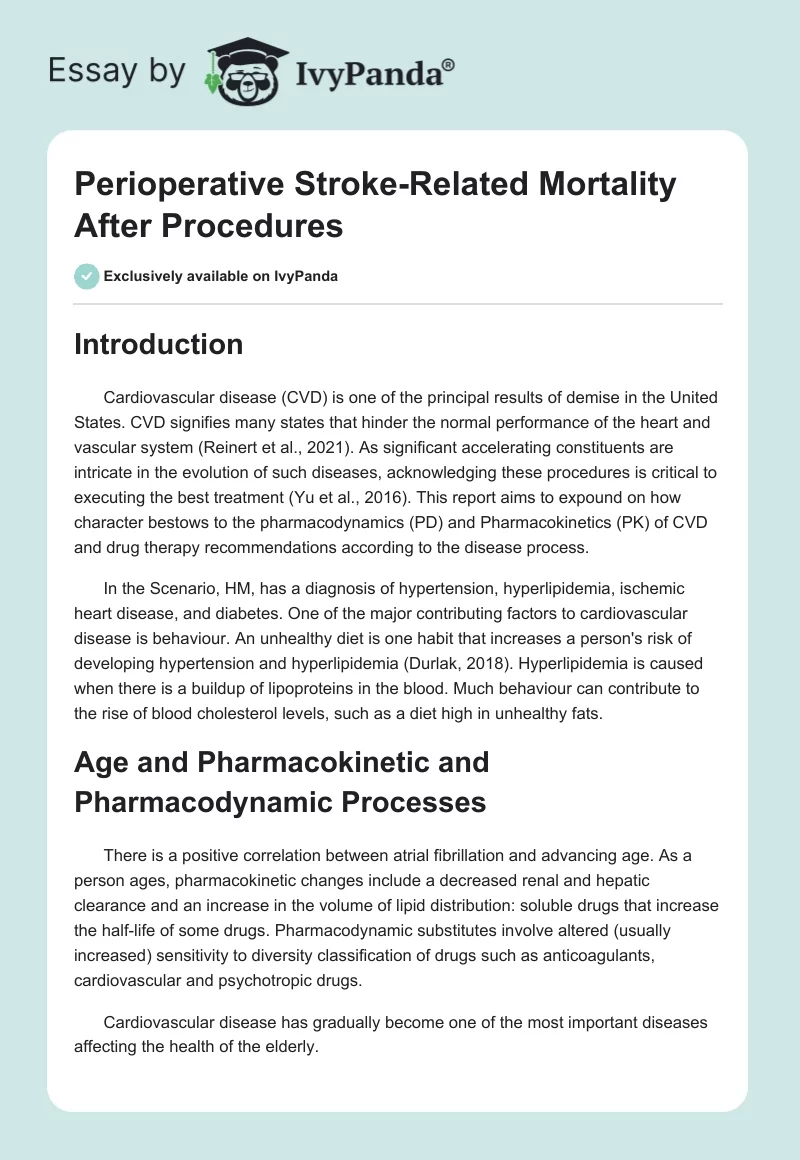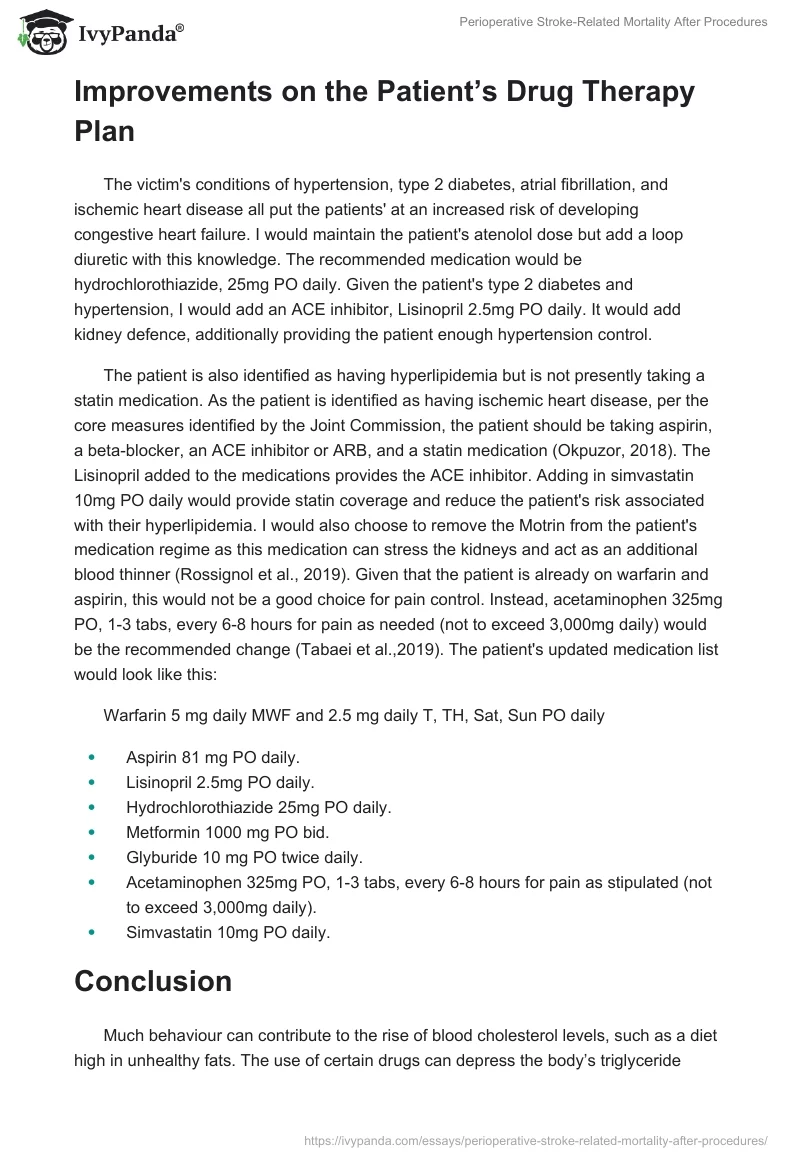Introduction
Cardiovascular disease (CVD) is one of the principal results of demise in the United States. CVD signifies many states that hinder the normal performance of the heart and vascular system (Reinert et al., 2021). As significant accelerating constituents are intricate in the evolution of such diseases, acknowledging these procedures is critical to executing the best treatment (Yu et al., 2016). This report aims to expound on how character bestows to the pharmacodynamics (PD) and Pharmacokinetics (PK) of CVD and drug therapy recommendations according to the disease process.
In the Scenario, HM, has a diagnosis of hypertension, hyperlipidemia, ischemic heart disease, and diabetes. One of the major contributing factors to cardiovascular disease is behaviour. An unhealthy diet is one habit that increases a person’s risk of developing hypertension and hyperlipidemia (Durlak, 2018). Hyperlipidemia is caused when there is a buildup of lipoproteins in the blood. Much behaviour can contribute to the rise of blood cholesterol levels, such as a diet high in unhealthy fats.
Age and Pharmacokinetic and Pharmacodynamic Processes
There is a positive correlation between atrial fibrillation and advancing age. As a person ages, pharmacokinetic changes include a decreased renal and hepatic clearance and an increase in the volume of lipid distribution: soluble drugs that increase the half-life of some drugs. Pharmacodynamic substitutes involve altered (usually increased) sensitivity to diversity classification of drugs such as anticoagulants, cardiovascular and psychotropic drugs.
Cardiovascular disease has gradually become one of the most important diseases affecting the health of the elderly.
Improvements on the Patient’s Drug Therapy Plan
The victim’s conditions of hypertension, type 2 diabetes, atrial fibrillation, and ischemic heart disease all put the patients’ at an increased risk of developing congestive heart failure. I would maintain the patient’s atenolol dose but add a loop diuretic with this knowledge. The recommended medication would be hydrochlorothiazide, 25mg PO daily. Given the patient’s type 2 diabetes and hypertension, I would add an ACE inhibitor, Lisinopril 2.5mg PO daily. It would add kidney defence, additionally providing the patient enough hypertension control.
The patient is also identified as having hyperlipidemia but is not presently taking a statin medication. As the patient is identified as having ischemic heart disease, per the core measures identified by the Joint Commission, the patient should be taking aspirin, a beta-blocker, an ACE inhibitor or ARB, and a statin medication (Okpuzor, 2018). The Lisinopril added to the medications provides the ACE inhibitor. Adding in simvastatin 10mg PO daily would provide statin coverage and reduce the patient’s risk associated with their hyperlipidemia. I would also choose to remove the Motrin from the patient’s medication regime as this medication can stress the kidneys and act as an additional blood thinner (Rossignol et al., 2019). Given that the patient is already on warfarin and aspirin, this would not be a good choice for pain control. Instead, acetaminophen 325mg PO, 1-3 tabs, every 6-8 hours for pain as needed (not to exceed 3,000mg daily) would be the recommended change (Tabaei et al.,2019). The patient’s updated medication list would look like this:
Warfarin 5 mg daily MWF and 2.5 mg daily T, TH, Sat, Sun PO daily
- Aspirin 81 mg PO daily.
- Lisinopril 2.5mg PO daily.
- Hydrochlorothiazide 25mg PO daily.
- Metformin 1000 mg PO bid.
- Glyburide 10 mg PO twice daily.
- Acetaminophen 325mg PO, 1-3 tabs, every 6-8 hours for pain as stipulated (not to exceed 3,000mg daily).
- Simvastatin 10mg PO daily.
Conclusion
Much behaviour can contribute to the rise of blood cholesterol levels, such as a diet high in unhealthy fats. The use of certain drugs can depress the body’s triglyceride removal mechanism. Genetics may cause some people are predisposed to develop high cholesterol even if they practice healthy lifestyles. This predisposition is due to an abnormal gene that leads to dysfunction of the lipoprotein reuptake receptors, decreasing elevated cholesterol levels clearance.
References
Durlak, D. (2018). Analysis of Nurses’ Knowledge in the Area of Prevention of Cardiovascular Diseases. Pielęgniarstwo Polskie, 70(4). Web.
Reinert, N. J., Patel, B. M., Al-Robaidi, K., Gao, X., Fabio, A., Jadhav, A.,… & Thirumala, P. D. (2021). Perioperative stroke-related mortality after non-cardiovascular, non-neurological procedures: A retrospective risk factor evaluation of common surgical comorbidities. Journal of perioperative practice, 31(3), 80-88.
Rossignol, P., Hernandez, A. F., Solomon, S. D., & Zannad, F. (2019). Heart failure drug treatment. The Lancet, 393(10175), 1034-1044.
Okpuzor, P. (2018). A Patient-Centered Approach to Diabetes Education in a Rural Clinic.
Tabaei, B. P., Chamany, S., Perlman, S., Thorpe, L., Bartley, K., & Wu, W. Y. (2019). Heart age, cardiovascular disease risk, and disparities by sex and race/ethnicity among New York City adults. Public health reports, 134(4), 404-416.
Yu, E., Rimm, E., Qi, L., Rexrode, K., Albert, C. M., Sun, Q.,… & Manson, J. E. (2016). Diet, lifestyle, biomarkers, genetic factors, and risk of cardiovascular disease in the nurses’ health studies. American journal of public health, 106(9), 1616-1623.


